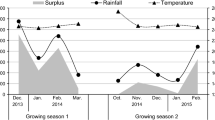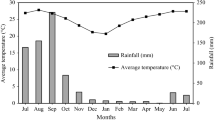Abstract
Understand how forage quality in semi-arid rangelands is modified by the botanical composition and climatological factors is essential for the appropriate nutritional management of the livestock. This study investigated the influence of the vegetal stratum and season on the bromatological composition of the forage in rangelands from a seasonally dry tropical forest in the Brazilian semi-arid. The experimental design was completely randomized with five replications, and the treatments consisted of two vegetal strata (herbaceous and shrub-arboreal), and two seasons (rainy and dry), in a two-year field trial. There was a significant effect of the season on the crude protein, fiber, hemicellulose, lignin, and soluble carbohydrates (p < 0.05), and the forage showed lower nutritional value during the dry season. Forage dry matter content was greater in the dry season (p < 0.05). There was a pronounced effect of the type of vegetation on the crude protein, fiber, hemicellulose, lignin, total and soluble carbohydrates (p < 0.05), and the herbaceous vegetation was characterized by greater content of fiber compounds and total carbohydrates, while the shrub-arboreal stratum by greater crude protein, soluble carbohydrates, and lignin. The cellulose content was greater in the herbaceous stratum (p < 0.05). The shrub-arboreal strata had greater contents of ether extract (5%), compared to the herbaceous vegetation (1%) (p < 0.05), and it was intensified by the dry season. Despite the mutual influence of the season and the vegetal strata on the bromatological composition of the forage, the type of vegetation of the semi-arid rangelands had a stronger effect in defining forage quality.

Source: Serra Talhada, PE, Brazil APAC/IMET (2014–2015)


Similar content being viewed by others
Data availability
The datasets generated during and/or analyzed during the current study are available in the Mendeley Data repository, http://dx.doi.org/10.17632/v8bkp92bw8.1
References
Albuquerque UP, Lima Araújo E, El-Deir ACA et al (2012) Caatinga revisited: ecology and conservation of an important seasonal dry forest. Sci World J. https://doi.org/10.1100/2012/205182
Araújo EL, Castro CC, Albuquerque UP (2007) Dynamics of Brazilian Caatinga: a review concerning the plants, environment and people. Funct Ecosyst Communit 1:15–28
Archimède H, Eugène M, Marie Magdeleine C et al (2011) Comparison of methane production between C3 and C4 grasses and legumes. Anim Feed Sci Technol 166–167:59–64. https://doi.org/10.1016/j.anifeedsci.2011.04.003
Bailey DW, Brown JR (2011) Rotational grazing systems and livestock grazing behavior in shrub-dominated semi-arid and arid rangelands. Rangel Ecol Manag 64:1–9. https://doi.org/10.2111/REM-D-09-00184.1
Bargel H, Koch K, Cerman Z, Neinhuis C (2006) Structure-function relationships of the plant cuticle and cuticular waxes: a smart material? Funct Plant Biol 33(10):893–910. https://doi.org/10.1071/FP06139
Coêlho JJ, Mello ACL, Santos MVF et al (2018) Prediction of the nutritional value of grass species in the semiarid region by repeatability analysis. Pesqui Agropecu Bras 53:378–385. https://doi.org/10.1590/S0100-204X2018000300013
Detmann E, Souza MA, Valadares Filho SC et al (2012) Métodos para análise de alimentos. Visconde do Rio Branco, MG Suprema 214
Figueiredo KV, Oliveira MT, Oliveira AFM et al (2012) Epicuticular-wax removal influences gas exchange and water relations in the leaves of an exotic and native species from a Brazilian semiarid region under induced drought stress. Aust J Bot 60:685–692. https://doi.org/10.1071/BT12168
Grice AC, Vanderduys EP, Perry JJ, Cook GD (2013) Patterns and processes of invasive grass impacts on wildlife in Australia. Wildl Soc Bull 37:478–485. https://doi.org/10.1002/wsb.314
Haydock KP, Shaw NH (1975) The comparative yield method for estimating dry matter yield of pasture. Aust J Exp Agric 15(76):663–670. https://doi.org/10.1071/EA9750663
Jones RM, Hargreaves JN (1979) Improvements to the dry-weight-rank method for measuring botanical composition. Grass Forage Sci 34:181–189. https://doi.org/10.1111/j.1365-2494.1979.tb01465.x
Jung HJG, Samac DA, Sarath G (2012) Modifying crops to increase cell wall digestibility. Plant Sci 185–186:65–77. https://doi.org/10.1016/j.plantsci.2011.10.014
Mannetje LT, Haydock KP (1963) The dry-weight-rank method for the botanical analysis of pasture. Grass Forage Sci 4:268–275. https://doi.org/10.1111/j.1365-2494.1963.tb00362.x
Marques TV, Mendes K, Mutti P et al (2020) Environmental and biophysical controls of evapotranspiration from seasonally dry tropical forests (Caatinga) in the Brazilian semiarid. Agric For Meteorol 287:107957. https://doi.org/10.1016/j.agrformet.2020.107957
Mcdonald SE, Reid N, Smith R et al (2019) Rotational grazing management achieves similar plant diversity outcomes to areas managed for conservation in a semi-arid rangeland. Rangel J 41:135–145. https://doi.org/10.1071/RJ18090
Meale SJ, Chaves AV, Baah J, McAllister TA (2012) Methane production of different forages in in vitro ruminal fermentation. Asian-Australas J Anim Sci 25:86–91. https://doi.org/10.5713/ajas.2011.11249
Moro MF, Nic Lughadha E, Araújo FS, Martins FR (2016) A phytogeographical metaanalysis of the semiarid Caatinga domain in Brazil. Bot Rev 82:91–148. https://doi.org/10.1007/s12229-016-9164-z
Muir JP, Santos MVF, Cunha MV et al (2019) Value of endemic legumes for livestock production on Caatinga rangelands. Rev Bras Ciências Agrárias: Brazilian J Agric Sci 14:1–12. https://doi.org/10.5039/agraria.v14i2a5648
Novara A, Gristina L, La Mantia T, Rühl J (2011) Soil carbon dynamics during secondary succession in a semi-arid mediterranean environment. Biogeosci Discuss 8:11107–11138. https://doi.org/10.5194/bgd-8-11107-2011
Oliveira OF, Santos MVF, Cunha MV et al (2016) Botanical composition of Caatinga rangeland and diets selected by grazing sheep. Trop Grassl-Forrajes Trop 4:71–81. https://doi.org/10.17138/tgft(4)71-81
Pareyn FGC, Pereira WE, Salcedo IH et al (2020) What controls post-harvest growth rates in the caatinga forest? Agric Meteorol 284:107906. https://doi.org/10.1016/j.agrformet.2020.107906
Pinto Filho JS, Cunha MV, Souza EJ et al (2019) Performance, carcass features, and non-carcass components of sheep grazed on Caatinga rangeland managed with different forage allowances. Small Ruminant Res 1(174):103–109. https://doi.org/10.1016/j.smallrumres.2019.03.010
Queiroz LP, Cardoso D, Fernandes MF, Moro MF (2018) Diversity and evolution of flowering plants of the Caatinga Domain. In: Caatinga: The largest tropical dry forest region in South America. Springer, pp 23–63. https://doi.org/10.1007/978-3-319-68339-3_2
Ribeiro EMS, Lohbeck M, Santos BA et al (2019) Functional diversity and composition of Caatinga woody flora are negatively impacted by chronic anthropogenic disturbance. J Ecol 107:2291–2302. https://doi.org/10.1111/1365-2745.13177
Rito KF, Arroyo-Rodríguez V, Queiroz RT et al (2017) Precipitation mediates the effect of human disturbance on the Brazilian Caatinga vegetation. J Ecol 105:828–838. https://doi.org/10.1111/1365-2745.12712
Santos JMFF, Santos DM, Lopes CGR et al (2013) Natural regeneration of the herbaceous community in a semiarid region in Northeastern Brazil. Environ Monit Assess 185:8287–8302. https://doi.org/10.1007/s10661-013-3173-8
Santos MVF, de Lira MA, Junior DJCB et al (2010) Potential of Caatinga forage plants in ruminant feeding. Rev Bras Zootec 39:204–215. https://doi.org/10.1590/s1516-35982010001300023
Schulz K, Guschal M, Kowarik I et al (2018) Grazing, forest density, and carbon storage: towards a more sustainable land use in Caatinga dry forests of Brazil. Reg Environ Chang 18:1969–1981. https://doi.org/10.1007/s10113-018-1303-0
Schulz K, Voigt K, Beusch C et al (2016) Grazing deteriorates the soil carbon stocks of Caatinga forest ecosystems in Brazil. For Ecol Manage 367:62–70. https://doi.org/10.1016/j.foreco.2016.02.011
Silva DLS, Oliveira KP, Aroeira LJM et al (2015) Chemical composition of caatinga potential forages species. Trop Subtrop Agroecosyst 18:267–272
Silva DS, de Andrade MVM, de Andrade AP et al (2011) Bromatologic composition of the herbaceous species of the Northeastern Brazil Caatinga. Rev Bras Zootec 40:756–764. https://doi.org/10.1590/S1516-35982011000400008
Souza BV, Souto PC, Souto JS et al (2019) Carbon in soil in different phisionomies of caatinga in Paraíba, Brazil. Floresta 49:287–296. https://doi.org/10.5380/rf.v49i2.57579
Williams DG, Baruch Z (2000) African grass invasion in the Americas: ecosystem consequences and the role of ecophysiology. Biol Invasions 2:123–140. https://doi.org/10.1023/A:1010040524588
Acknowledgements
Grants from Conselho Nacional de Desenvolvimento Científico e Tecnológico (CNPq). Grants. For the postdoctoral scholarship of the Fundação de Amparo à Ciência e Tecnologia do Estado de Pernambuco (FACEPE), Grant Number BFP-0126-5.04/19.
Funding
CNPq—National Council for Scientific and Technological Development—Brazil. Grant number 480755/2012–4.
Author information
Authors and Affiliations
Contributions
MJG Investigation, MJG data curation, CMV Project administration, Funding Acquisition; SEJO Supervision CJJ Writing formal, Formal analysis; SMVF; SEJO; DJJCB; MACL Conceptualization.
Corresponding author
Ethics declarations
Conflict of interest
The authors declare that they have no conflict of interest.
Additional information
Publisher's Note
Springer Nature remains neutral with regard to jurisdictional claims in published maps and institutional affiliations.
Rights and permissions
About this article
Cite this article
de Moura, J.G., da Cunha, M.V., de Souza, E.J.O. et al. The vegetal stratum defined the forage bromatology more than the season in seasonal dry tropical forest rangelands. Agroforest Syst 95, 1177–1189 (2021). https://doi.org/10.1007/s10457-021-00644-4
Received:
Accepted:
Published:
Issue Date:
DOI: https://doi.org/10.1007/s10457-021-00644-4




